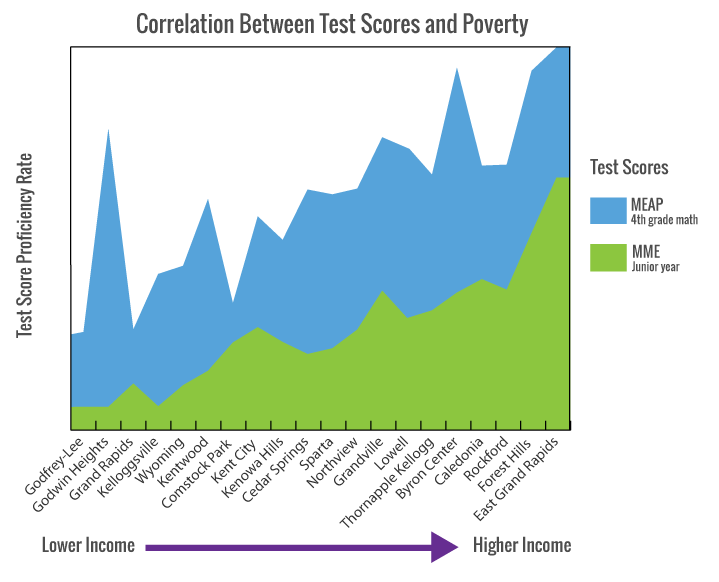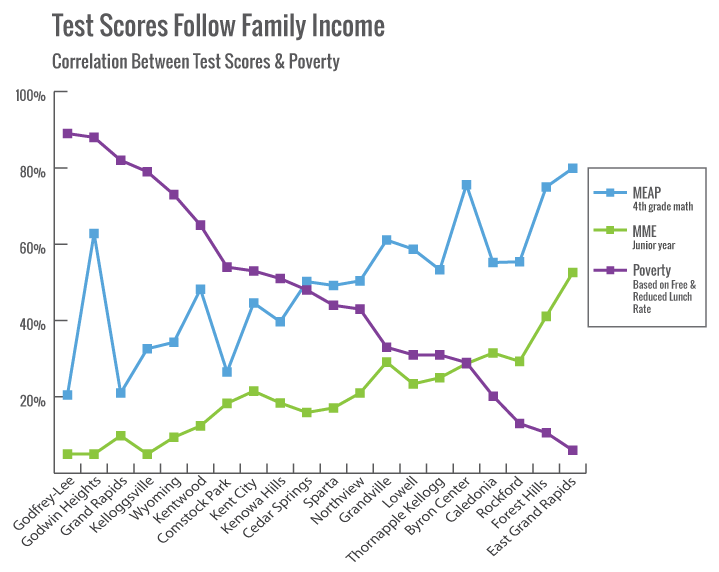The higher the poverty, the lower the test scores. That’s the general story of academic achievement in Kent County public schools.
Further, students’ economic hardships unfairly penalize poorer school districts when it comes to statewide rankings of their performance, experts say. 
An analysis by School News Network as part of the School News Network series The Burden of Poverty, a Backpack of Heartache, shows a close correlation between poverty and performance in the 20 school districts of the Kent ISD. In almost all cases, the districts with the lowest family income levels also had the lowest scores on standardized tests.
By that metric, Godfrey Lee Public Schools was the poorest district in 2013-14, and had the lowest or next-to-lowest test scores in three test categories. Conversely, East Grand Rapids had the highest family income and the highest scores. Most other districts followed a similar pattern except Godwin Heights, which ranked fourth in math scores despite being the second-poorest district.
Despite its small sampling, the SNN analysis shows a statistically “strong correlation” between income and test scores, said Nick Ceglarek, superintendent of Hudsonville Public Schools. Ceglarek wrote his doctoral dissertation at Eastern Michigan University on the statistical link between economically disadvantaged students and their schools’ performance in Michigan’s Top-to-Bottom academic ranking system.
“The findings you had are consistent with what research is out there (on) the influence poverty has on learning and achievement,” said Ceglarek, whose dissertation reviewed past studies.
A researcher with a leading education advocacy group agreed the local numbers are typical of broader findings.
“It’s unfortunate and sad, but this isn’t all that surprising,” said Sarah Winchell Lenhoff, director of policy and research for The Education Trust-Midwest. “These are trends that we see everywhere. Unfortunately, poverty is a very strong predictor of student achievement.”

Well Documented Pattern
Poverty’s predictive influence has been documented in studies dating back almost 50 years. A landmark 1966 study commissioned by the U.S. Department of Education surveyed staff and students from 4,000 schools. It identified the effects of socioeconomic status as “the most powerful predictor of student success,” Ceglarek wrote in his dissertation.
“Schools bring little influence to bear on a child’s achievement that is independent of his background and general social context,” the federal study noted, adding the “inequality imposed on children by their home, neighborhood, and peer environment” follows them throughout school.
Ceglarek cites subsequent studies showing a growing achievement gap between lower- and higher-income students, and research asserting state testing and federal reform programs have not made a major impact on it.
In a 2009 nationwide analysis, the Federal Education and Budget Project found students’ proficiency in standardized eighth-grade math and reading tests was nearly twice as high in states with the lowest poverty compared to those with the highest poverty.
But while national test scores indicate the gap is narrowing for elementary students, Michigan’sgap has remained more or less constant for a decade, Lenhoff said. And contrary to popular myth, she said, the test scores of Michigan’s white and higher-income students — not just those of minorities and low-income students — are sliding nationally.
“To say our education problem is just about certain groups of kids is to ignore the fact all of our kids are not doing as well as they should be,” Lenhoff said. “Frankly, we’re all falling behind.”
Michigan Trails Other States
Despite the persistence of poverty’s drag on achievement, Michigan is not addressing its problems as effectively as some other states, Lenhoff and others agree.
In its latest Kids Count Data Book, the Annie E. Casey Foundation rated Michigan 32nd in its state ranking of child well-being, and 38th in education. “These results show starkly different conditions in our state for children of different races and places,” Jane Zehnder-Merrell, director of Kids Count in Michigan, said in a statement quoted by MLive.
Further, a new report cited by the Michigan League for Public Policy finds state funding cuts for K-12 education are the 15th worst in the nation since 2008. Per-pupil spending is $615 below pre-recession levels taking inflation into account, according to the national Center on Budget and Policy Priorities. Gov. Rick Snyder’s office disputed the finding. The report can be read here.
The achievement disparity between lower- and higher-income districts is reinforced by Michigan’s Top-to-Bottom ranking system, Ceglarek argues. The annual list ranks schools on academic achievement and improvement, graduation rates, and gaps between the highest- and lowest-achieving students.
Ceglarek maintains the system penalizes low-income districts. In analyzing rankings from 2011-12 and 2012-13, he found 75 percent of the lowest-ranked schools had the highest rates of students qualifying for free or reduced lunch. By being so closely tied to income, the rankings are “essentially celebrating low poverty,” he said.
He devised a system that would give weight to students’ family income in comparing schools, potentially raising the rankings of low-income schools and reducing those of high-income schools.
Godfrey-Lee Public Schools is one district that would benefit from the revised ranking. The deeper problem, however, is lack of funding targeted at the highest-need schools, said Godfrey-Lee Superintendent David Britten.
“Michigan’s school funding scheme has nearly zero correlation to schools that require more funding to serve a larger at-risk population of students,” Britten said. “Our school funding system is purposely designed to create winners and losers.”
In a blog post a year ago, Britten statistically demonstrated how closely poverty drives the state Top-to-Bottom list, dismissing the latter as “nothing more than another blinding flash of the obvious.” Britten’s blog post can be read here.
Wrote Britten, “(T)he question is, when are we going to quit wasting time collecting data that only tells us the obvious and spend more time and other resources on ending poverty and overcoming the effects of inequity in school funding?”
CONNECT
Read the full series: The Burden of Poverty: A Backpack of Heartache









